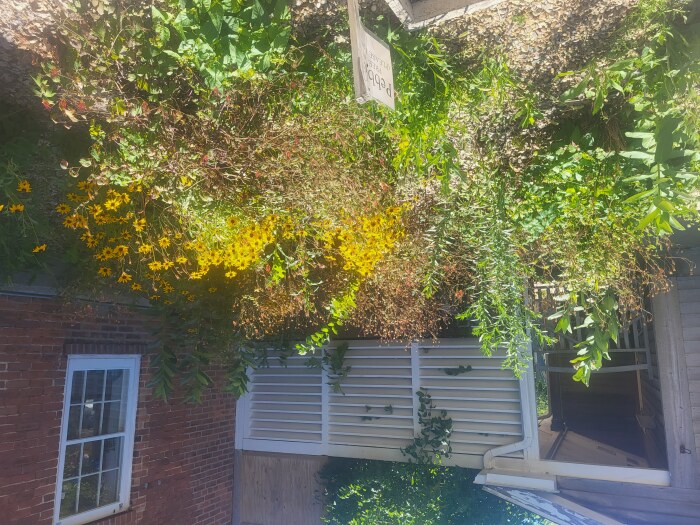Kara Grady is a wildflower enthusiast living in eastern Iowa. Her work has been published in the Erythronium newsletter of the Iowa Native Plant Society. When she’s not going on rare flower adventures, she can be found reading the latest botanical books or attending prairie seminars.
Sitting down outside the crystal store in Amana, my eye was drawn to a sign half-hidden across the way. It was not studded with sparkly jewels, or advertised by bright colors, but nevertheless, I was pulled from my seat with curiosity to investigate. And I experienced a surge of joy when I realized what the sign was for: it was telling me of the Monarch Waystation planted right in front of the store, an array of wildflowers I had barely noticed moments before.

Monarch Waystations, pollinator plantings, and prairie pockets are just some of the names these smaller wildflower patches have gained in the last few years, as they have gained popularity with landowners in urban and suburban areas. Thanks to the conservation efforts of experts such as Doug Tallamy, the Monarch Joint Venture, Wild Ones chapters, and many others, people are taking little (or large) bits of land and turning them into beautiful havens for on-the-brink species such as the monarch butterfly.
I had several encounters with these small but mighty plots, including the one in Amana. It provided everything monarch butterflies needed to thrive—food, shelter, and nectar—in about a 10 ft by 10 ft area, packed with flowers. The vibrant colors of purple, red, and yellow lent a nice touch to the crystal store’s façade.

Species planted included the brown branches of faded wild columbine (a spring bloomer), wild petunia (a summer bloomer), black-eyed Susan (a summer to fall bloomer), and their monarch food of choice, common milkweed.

Common Milkweed (Asclepia syriaca)

Wild Petunia (Ruellia humilis)
For those who created the site, it was important to give the monarch caterpillars and butterflies food and nectar throughout the growing season, hence the staggered bloom times. I found joy in a monarch egg attached to the bottom of a milkweed leaf.

My wildflower-finding dad told me about another Monarch Waystation, located at the Fairfax Public Library in Linn County. When I finally drove down, I was first greeted by the cheerful yellow of Canada goldenrod, upright and blooming despite the intense heat.

Canada Goldenrod (Solidago canadensis)

Finding my way around to the back, I discovered a patch of mostly faded flowers. The mix included the deep magenta of ironweed (late summer), dusty pink swamp milkweed (early summer), shriveled purple coneflower (spring-early summer), and common milkweed (summer) whose seed pods had begun to emerge.

Ironweed (Vernonia fasciculata)

Purple Coneflower (Echinacea purpurea)

Swamp Milkweed (Asplecias incarnata)

Common Milkweed (Asclepia syriaca)

Common Milkweed seed pods
I had a personal hand in one monarch waystation planting at my grandparent’s own yard. I helped move and plant several great blue lobelias (summer) into their yard, whose gorgeous indigo blooms attracted bees and stares from our family at our annual Christmas in July.

Great Blue Lobelia (Lobelia siphilitica)
That inspired my grandparents to plant more natives in a strip of sod the previous homeowners had left. After digging out a tree stump and keeping a plastic tarp over the area for several weeks to kill off weeds, they collaborated with a local native nursery (in their case, Midwest Natives) to pick out plants and create their own design, which they planted at the end of August. Here’s the design of the plot:

And here’s the pollinator patch in its early stages of growth.

I cannot wait to see the beautiful succession of blooms their garden will give them next year, as well as plenty of thriving monarchs!
All photos are published with permission. Most are by Kara Grady, except for Steve Simonsen’s pictures of the author’s grandparent’s new plot and associated graph.


1 Comment
Thanks, Kara Grady, for this cheering magic!
I have friends who live in Ames and tell me that Ames is embarking on a campaign to make that city more pollinator-friendly. I hope pollinators will soon enjoy much more habitat in Ames, and I hope other towns and cities in Iowa will follow Ames’ example.
Monoculture lawns are not much better for soil, water, air, and pollinators than parking lots. And there are so many large lawns in Iowa that are not used by humans, let alone wildlife, and seem to benefit no one except the lawn care and fossil fuels industries. Iowa could have so many more small wildflower plantings. A friend put in a strip prairie planting two years ago, and it looks beautiful this year, with lots of happy butterflies, bees, and other visitors.
PrairieFan Thu 28 Sep 5:34 PM